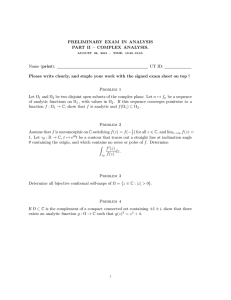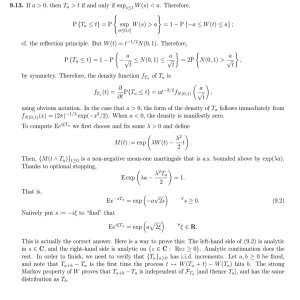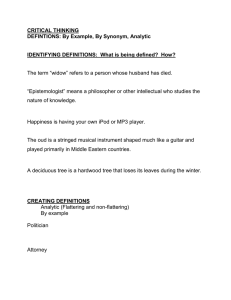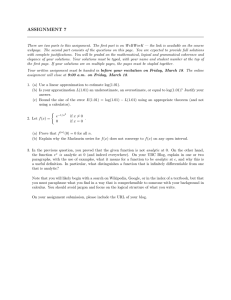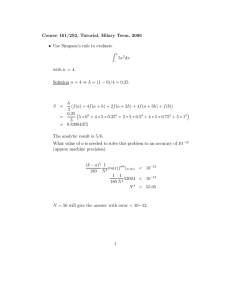LR LR LR LR x 62 N.
advertisement
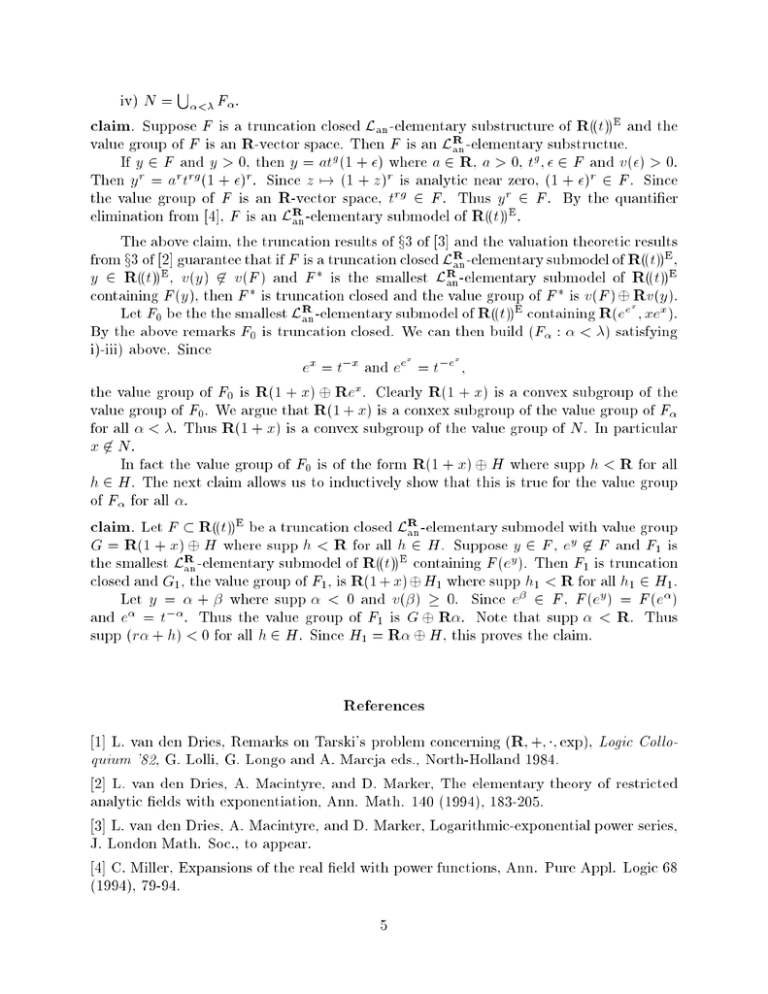
S iv) N = < F. claim. Suppose F is a truncation closed Lan -elementary substructure of R((t))E and the value group of F is an R-vector space. Then F is an LRan -elementary substructue. If y 2 F and y > 0, then y = atg (1 + ) where a 2 R, a > 0, tg ; 2 F and v() > 0. Then yr = ar trg (1 + )r . Since z 7! (1 + z)r is analytic near zero, (1 + )r 2 F . Since the value group of F is an R-vector space, trg 2 F . Thus yr 2 F . By the quantier elimination from [4], F is an LRan -elementary submodel of R((t))E. The above claim, the truncation results of x3 of [3] and the valuation theoretic results from x3 of [2] guarantee that if F is a truncation closed LRan -elementary submodel of R((t))E, y 2 R((t))E, v(y) 62 v(F ) and F is the smallest LRan -elementary submodel of R((t))E containing F (y), then F is truncation closed and the value group of F is v(F ) xRv(y). Let F0 be the the smallest LRan -elementary submodel of R((t))E containing R(ee ; xex ). By the above remarks F0 is truncation closed. We can then build (F : < ) satisfying i)-iii) above. Since ex = t?x and eex = t?ex ; the value group of F0 is R(1 + x) Rex. Clearly R(1 + x) is a convex subgroup of the value group of F0. We argue that R(1 + x) is a conxex subgroup of the value group of F for all < . Thus R(1 + x) is a convex subgroup of the value group of N . In particular x 62 N . In fact the value group of F0 is of the form R(1 + x) H where supp h < R for all h 2 H . The next claim allows us to inductively show that this is true for the value group of F for all . claim. Let F R((t))E be a truncation closed LRan -elementary submodel with value group G = R(1 + x) H where supp h < R for all h 2 H . Suppose y 2 F , ey 62 F and F1 is the smallest LRan -elementary submodel of R((t))E containing F (ey ). Then F1 is truncation closed and G1 , the value group of F1, is R(1+ x) H1 where supp h1 < R for all h1 2 H1 . Let y = + where supp < 0 and v( ) 0. Since e 2 F , F (ey ) = F (e) and e = t?. Thus the value group of F1 is G R. Note that supp < R. Thus supp (r + h) < 0 for all h 2 H . Since H1 = R H , this proves the claim. References [1] L. van den Dries, Remarks on Tarski's problem concerning (R; +; ; exp), Logic Colloquium '82, G. Lolli, G. Longo and A. Marcja eds., North-Holland 1984. [2] L. van den Dries, A. Macintyre, and D. Marker, The elementary theory of restricted analytic elds with exponentiation, Ann. Math. 140 (1994), 183-205. [3] L. van den Dries, A. Macintyre, and D. Marker, Logarithmic-exponential power series, J. London Math. Soc., to appear. [4] C. Miller, Expansions of the real eld with power functions, Ann. Pure Appl. Logic 68 (1994), 79-94. 5 and there is no point (x; y) 2 V n fpg such that y = f (x) and g(x; y) = 0. Note that for each m n there is an analytic hm on V such that @ mF (x; y) = m!(y ? f (x))n?mg(x; y) + (y ? f (x))h (x; y): m @ym Let G = @@yn?n?1F1 . Then G is an LRan;exp-term, G vanishes identically on ? \ V and @G @y does not vanish on ? \ V n fpg. By analytic continuation and o-minimality G(x; f (x)) = 0 and @G (x; f (x)) 6= 0 @y for suciently large x. Since (eez ; zez ) parameterizes the curve y = f (x), G(eez ; zez ) = 0 for suciently large z. Dierentiating with respect to z we see that z ez ; zez ) + (z + 1)ez @G (eez ; zez ) 0 = ez ee @G ( e @x @y and (eez ; zez ) z @G e @x (1) z = ?e @G ez z ? 1 @y (e ; ze ) for suciently large z. Suppose M is a nonstandard model of the Lan;exp-theory ofx R, x 2 M, and x > R. Let N be the smallest LRan;exp-substructure of M containing R(ee ; xex), i.e. N is the smallest x subset of M containing R(ee ; xex) and closed under LRan -terms and exponentiation. In x R e x fact N is the smallest Lan -elementary submodel of M containing R(e ; xe ) and closed R under exp. Since G and @G @y are Lan;exp -terms, x 2 N . We will obtain a contradiction by showing this fails when M is the logarithmic-exponential series eld R((t))LE constructed in [3]. For the remainder of the proof we assume familiarity with the notation and results from [3]. Lemma 2. Let x = t?1 2 Rx ((t))LE. Let N R((t))LE be the smallest LRan;exp -substructure of R((t))LE containing R(ee ; xex). Then x 62 N . Proof. We rst note that in fact N R((t))E. We build a chain (F : < ) of truncation closed LRan -elementary substructures of N such that: S i) F = < F if is a limit ordinal, ii) there is y 2 F such that F+1 is the smallest LRan -elementary submodel of R((t))E containing F (ey ) for all < , and 4 i) there is an open Vi Ui containing a tail of ? such that ti(x; y) 2 (?1; 0] [ (1; +1) for all (x; y) 2 Vi; ii) there is an open Vi Ui containing a tail of ? such that ti(x; y) = 1 for all (x; y) 2 Vi; iii) there is an open Vi Ui containing a tail of ? such that 0 < ti(x; y) < 1 for all (x; y) 2 Vi, iv) there is an open set Vi Ui containing a tail of ? such that ti(x; f (x)) = 0 but fy : (x; y) 2 Vi ^ ti(x; y) = 0g is nite for suciently large x, or v) there is an open set Vi Ui containing a tail of ? such that ti(x; f (x)) = 1 but fy : (x; y) 2 Vi ^ ti(x; y) = 1g is nite for suciently large x. Cases iv) or v) are the cases where our induction breaks down. In case iv) we replace F by ti(x; y). Then ti(x; y) satises () and ti and all of its subterms are analytic on Vi. In case v) we replace F by ti(x; y) ? 1. In either case the new term has the desired property. In case i) gb(t1 ; : : : ; tn) = gb(t1 ; : : : ; ti?1; 0; ti+1; : : : ; tn ) for all (x; y) 2 Vi. Thus we could replace this occurence of ti by 0 to obtain a new term F such that F = F on an open set containing a tail of ?. This contradicts our assumptions on F . Similarly in case ii) we can replace this occurence of ti by 1 contradicting our assumptions of F . T Thus we may assume we are in case iii). Let V = ni=1 Vi. Then (t1 (x; y); : : : ; tn(x; y)) 2 (0; 1)n for all (x; y) 2 V and h is analytic on V . Suppose t is a subterm of F analytic on an open set U containing a tail of ? and g = tr . By cell decompostion we can nd an open set V U containing a tail of ? such that one of the following holds: i) t(x; y) 0 for all (x; y) 2 V , ii) t(x; f (x)) = 0 and fy : (x; y) 2 V ^ t(x; y) = 0g for suciently large x, or iii) t(x; y) > 0 for (x; y) 2 V . As above case i) can not happen as we could simplify F by replacing g by 0. In case ii) we can use t instead of F and we are done. Thus we may assume that we are in case iii) and note that g is analytic on V . This completes the induction. Either we will nd a simpler term satisfying the conditions of the theorem or we will eventually thin U to an open V containing a tail of ? such that F is analytic on V . Let F (x; y) be the term guaranteed by lemma 1. Note that since F and all of its subterms are analytic on U , one can show by induction that all of the partial derivatives of F are LRan;exp-terms. Let p 2 ? \ U . By repeated application of the Weierstrass division theorem we can nd an open neighborhood V of p, n 2 N and an analytic function g on V such that on V F (x; y) = (y ? f (x))ng(x; y) 3 is not equivalent to a quantier free formula in the language f+; ?; ; <; 0; 1; expg (or any expansion by total real analytic functions), while, in unpublished work, van den Dries and Macintyre showed that ? 9z z2 = x ^ y = ez is not equivalent to a quantier free formula in the language f+; ?; ; x1 ; exp; <; 0; 1g. Both of these formulas are equivalent to a quantier free LRan;exp-formulas. The most interesting open question of this kind is whether the theory of (R; +; ; exp) admits quantier elimination in either the langauge L = f+; ; ?; <; 0; 1g [ fexp; logg or L augmented by all semialgebraic functions. It seems that to eliminate quantiers one needs to add some implicitly dened restricted analytic functions, so we expect both of these questions to have a negative answer. Let f (x) = (log x)(log log x) and let ? be the graph of f . We say that an open set U R2 contains a tail of ? if (x; f (x)) 2 U for all sucently large. If (x; y) is equivalent to a quantier free LRan;exp-formula, then there is an LRan;exp term F (x; y) such that G(x; f (x)) = 0 and for suciently large x there are only nitely many y such (x; y) 2 U and G(x; y) = 0. Lemma 1. There is an LRan;exp -term F (x; y) which is analytic on an open U R2 containing a tail of ? such that F (x; f (x)) = 0 for suciently large x, and for all x there are at most nitely many y such that (x; y) 2 U and F (x; y) = 0. Moreover, we can choose F such that all of its subterms are analytic on U . Proof. We know there is an LRan;exp -term F (x; y) with the following property: () There is an open U R2 containing a tail of ? such that F (x; f (x)) = 0 for suciently large x and for all x there are at most nitely many y such that (x; y) 2 U and F (x; y) = 0. We may, by induction on terms, assume that if any nonconstant subterm of F is replaced by the constant term 0 or 1, then the resulting term does not have property (). We next try to nd an open V U containing a tail of ? such that F and all of its subterms are analytic on V . We try to prove this by induction on subterms of F . We will see that the only obstructions to this induction will lead to a new term F1 with property () such that F1 and all of its subterms are analytic on an open set containing a tail of ?. If a subterm t of F is a constant or variable, it is analytic on all of U . Suppose t0 and t1 are a subterms of F and ti is analytic on Vi where Vi is an open subset of U containing a tail of ?. Then V = V0 \ V1 contains a tail of ? and t0 t1 , t0 t1 and exp(ti) are analytic on V . Suppose t1 ; : : : ; tn and h = bg(t1 ; : : : ; tn ) are subterms of F , where gb is the function symbol for a restricted analytic function and t1 ; : : : ; tn are analytic on an open set Ui containing a tail of ?. By cell decomposition one of the following holds for each i: 2 A failure of quantier elimination Angus Macintyre* Oxford University David Marker** University of Illinois at Chicago We let Lan be the rst order language of ordered rings augmented by function symbols fb where f is an analytic function dened on an open U [0; 1]n for some n. We interpret fb as a function on Rn by n x 2 [0; 1]n : b f (x) = f0 (x) ifotherwise Let LRan be the language obtained by adding to Lan function symbols fr for each r 2 R. We interpret fr as the function n r if x > 0 fr (x) = 0x otherwise and denote fr (x) by xr . Finally we let Lan;exp be the language Lan [ fexpg and LRan;exp = LRan [ fexpg. In [2] we showed that the Lan;exp-theory of R admits quanter elimination in the language Lan;exp [ flogg. Indeed, we remark there that exp is unnecessary as we could actually eliminate quantiers in the language Lan [ flogg [ fxq : q 2 Qg. Here we show that although exp and log are interdenable, log is essential for quantifer elimination. Theorem. Let (x; y) be the formula 9z (exp(exp z) = x ^ y = z exp z): Then (x; y) is not equivalent to a quantier free LRan;exp-formula. Of course (x; y) is equivalent to the quantier free Lan [ flogg-formula x > 1 ^ y = (log x)(log log x): There are several previous \failure of quantier elimination" theorems for the reals with exponentiation. In [1] van den Dries showed that Osgood's example y > 0 ^ 9w (wy = x ^ z = yew ) * Partially supported by EPSRC Senior Research Fellowship. ** Partially supported by NSF grants DMS-9306159 and INT-9224546, and an AMS Centennial Fellowship. 1

